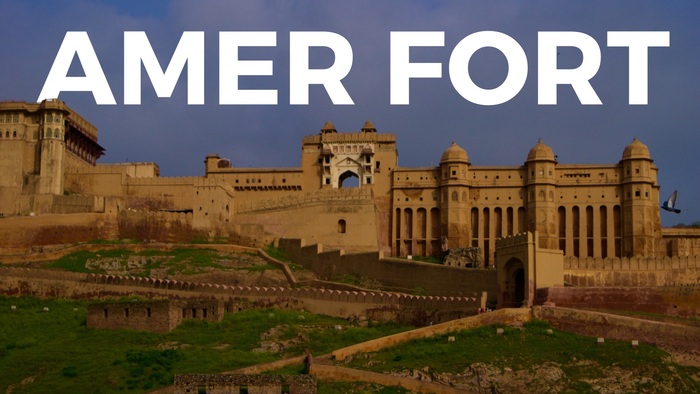Situated in Amer, Rajasthan, India, Amer Fort, also known as Amber Fort, stands as a magnificent fortress. Amer, a charming town spanning an area of 4 square kilometers (1.5 sq mi), lies merely 11 kilometers (6.8 mi) away from Jaipur, the capital of Rajasthan. Perched atop a hill, this majestic Amer Fort in Jaipur serves as the primary attraction for tourists visiting the city.
Renowned for its splendid artistic style, Amer Fort showcases grand ramparts, a series of gates, and enchanting cobbled paths. It overlooks the serene Maota Lake, which serves as the primary water source for the fort.
Known as one of the most famous Palaces and Forts in Rajasthan, the Amer fort is a must visit for anyone staying in Jaipur. Let’s dive into the history of the fort, architecture, and why it is one of the most famous tourist attractions in the Pink City of India.
Quick Facts of the Amber Fort Jaipur:
Below are some important quick facts to know about the Amber Fort in Jaipur:
| Entry Price for the Amber Fort Jaipur | 25 per person for Indians 10 per person for Indian Students 550 per person for Foreign Tourists 100 per person for Foreign Students 1,100 per couple for Elephant Ride |
| Operating times of the Amber Fort Jaipur | The Amber fort in Jaipur operates seven days a week. Morning: 8:00 am to 5:30 pm Night: 6:30 pm to 9:15 pm |
| Amber Fort Jaipur Address | Devisinghpura, Amer, Jaipur, Rajasthan, 302001, India |
| Light Show Timing and Cost | English: 7:30 pm – 200 per person for Light Show in English Hindi: 8:00 pm – 100 per person for Light Show in English |
| Elephant Ride Timings and Price | Elephant rides are available from 7:30 am to 12:30 pm everyday and cost INR 1,100. Please see note below! |
| Commissioned by | Raja (King) Man Singh |
| Architectural Style | Blend of Mughal and Rajput architecture |
| Status | UNESCO World Heritage Site (2013) |
| Area | 988.422 acres |
| Year of Establishment | 1592 |
| Material Used | Red sandstone and marble |
| Best Time to Visit | Winters – (October to February) |
Note on Elephant Rides: However, I strongly recommend against riding the elephants as there are ethical issues regarding the well being of the animals. Whereas, riding elephants poses significant risks to their well-being, as their spines are not designed to bear the weight of people. Subjecting them to such pressure can result in permanent spinal injuries.
Additionally, the use of chairs (howdahs) attached to their backs can cause discomfort and lead to painful blisters, which may become infected. It is crucial to prioritize the welfare and health of these majestic animals by refraining from engaging in activities that exploit them and cause harm.
Overview of the Amer Fort in Jaipur:
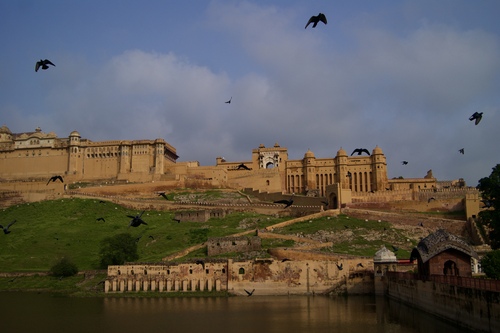
The Amer Palace stands as a remarkable testament to Rajput architecture, showcasing a fusion of influences from Mughal design. Crafted with red sandstone and marble, this captivating and luxurious palace spans four levels, each adorned with its own courtyard. Within its walls, one can explore the Diwan-e-Aam, or “Hall of Public Audience,” the Diwan-e-Khas, or “Hall of Private Audience,” the Sheesh Mahal (mirror palace), also known as Jai Mandir, and the Sukh Niwas, where cool breezes created by a cascading water feature offer respite from the heat. Throughout history, this palace served as the residence for the Rajput Maharajas and their families.
As one approaches the palace, near the Ganesh Gate of the fort, a temple dedicated to Shila Devi, a Goddess of the Chaitanya cult, can be found. This temple was bestowed upon Raja Man Singh after his victory over the Raja of Jessore, Bengal in 1604 (now part of Bangladesh). Raja Man Singh, having twelve queens, constructed twelve rooms, one for each queen. Each room had a staircase leading to the king’s chamber, although the queens were not permitted to ascend. Raja Jai Singh, on the other hand, had only one queen and thus built a room equivalent to the size of three of the old queen’s chambers.
Adjacent to the Amer Palace, atop the Cheel ka Teela (Hill of Eagles) within the Aravalli range, lies the the famous Jaigarh Fort. The palace and Jaigarh Fort come together to make a cohesive complex, connected by an underground tunnel designed as an escape route during times of war, allowing the royal family and other inhabitants of the fort to seek refuge in the formidable Jaigarh Fort.
The Amer Palace attracts a substantial number of tourists annually, with approximately 5,000 visitors per day and 1.8 million visitors in 2017, as reported by the Global Heritage Fund who helped build a management plan for the fort. Furthermore, at the 37th session of the World Heritage Committee in Phnom Penh, Cambodia, in 2013, the Amer Fort, along with five other forts in Rajasthan, was recognized as a UNESCO World Heritage Site, collectively known as the Hill Forts of Rajasthan.
Where is the Amber Palace in Rajasthan Located?
Perched majestically on a wooded hill that extends into the Maota Lake, the Amer Palace is located near the town of Amer, approximately 11 kilometers (6.8 mi) from the vibrant city of Jaipur, Rajasthan’s capital.
The palace enjoys proximity to National Highway 11C, which connects it to Delhi and makes up one of the three corners of the Golden Triangle in India. Access to the fort is facilitated by a narrow 4WD road that leads to the grand entrance gate, famously known as the Suraj Pol, or Sun Gate. In line with evolving ethical standards, it is now encouraged for tourists to opt for jeep rides as a means of reaching the fort, rather than riding elephants.
History of the Amer Fort in Jaipur:

Amer, previously a Meena state, was governed by the Susawat clan, led by their ruler Kakil Deo’s son, Dulherai. After emerging victorious over Kakil Deo, Dulherai established Amber as the capital of Dhundhar, succeeding Khoh.
The construction of the magnificent Amber Fort was initiated by Raja Man Singh, with subsequent expansions undertaken by Jai Singh I. Over the course of 150 years, successive rulers made improvements and additions to the fort until the Kachwahas eventually shifted their capital to Jaipur during the reign of Sawai Jai Singh II in 1727.
Previously known as Dhundar in the medieval era, Amber was governed by the Kachwahas from the 11th century until 1727 when the capital was relocated to Jaipur. The history of Amer is inseparably intertwined with these rulers, as they established their empire in Amber.
Conservation efforts of the Amer Fort Jaipur:
During the 37th meeting of the World Heritage Committee in Phnom Penh in June 2013, six forts of Rajasthan, namely Amber Fort, Chittor Fort, Gagron Fort, Jaisalmer Fort, Kumbhalgarh, and Ranthambore Fort, were added to the UNESCO World Heritage Site list. These forts were recognized as a serial cultural property and exemplary Rajput military hill architecture.
The town of Amer, an essential entry point to Amer Palace, has now transformed into a heritage town heavily reliant on tourists. Covering an area of 4 square kilometers (1.5 sq mi), the town boasts eighteen temples, three Jain mandirs, and three mosques. It has been included on the World Monument Fund’s list of 100 endangered sites, and conservation efforts receive support from the Robert Wilson Challenge Grant. However, the well-being of the elephants within the fort grounds has raised concerns, as some were reported to be suffering from malnutrition in 2005.
The Amer Development and Management Authority (ADMA) has undertaken conservation work at the Amer Palace grounds, investing approximately Rs 40 crores (US$8.88 million). Nevertheless, these renovation efforts have sparked intense debates and criticisms regarding their appropriateness in preserving the historical and architectural integrity of the ancient structures.
In a regrettable incident, a film unit shooting at the Amer Fort caused damage to a 500-year-old canopy, demolished the old limestone roof of Chand Mahal, drilled holes to set up their equipment, and spread large quantities of sand in Jaleb Chowk. These actions violated the Rajasthan Monuments, Archaeological Sites and Antique Act (1961). The Jaipur Bench of the Rajasthan High Court intervened, halting the film shooting and remarking that “unfortunately, not only the public but especially the authorities concerned have become blind, deaf, and mute in the face of money’s allure. Historical protected monuments have become a source of income.”
The Architecture of the Amber Palace in Rajasthan:
The Amber Palace in Jaipur is a vast complex with multiple courtyards, architectural wonders, and mandirs and beautiful gates. The sections below showcase the different areas of the fort and what you can expect to see while visiting.
Overall Layout of the fort:
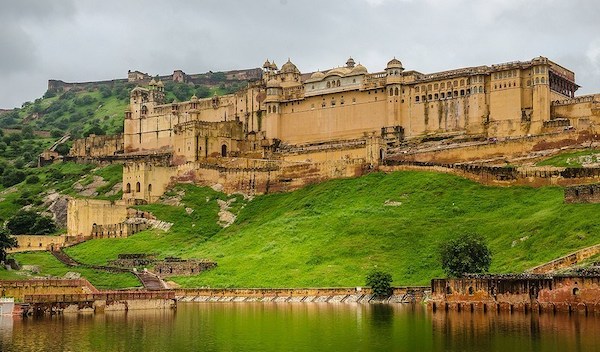
The Palace is meticulously divided into six distinct sections, each boasting its own entrance gate and courtyard. The primary gateway, known as the Suraj Pol or Sun Gate, grants access to the first main courtyard. This grand space served as the venue for victorious army processions, where soldiers proudly showcased their spoils of war upon their return. This gate stood as the principal entry point into the palace. Its orientation towards the east, welcoming the rising sun, lends it its name.
Jaleb Chowk, an Arabic term denoting a gathering place for soldiers, is one of the four courtyards within the Amer Palace. It was erected during the reign of Sawai Jai Singh (1693-1743 AD). This courtyard hosted parades conducted by the Maharaja’s personal bodyguards, under the command of the army’s leader, the Fauj Bakshi. The Maharaja himself would inspect the contingent of guards stationed here.
Let’s take a deeper look at the overall layout of Amer Fort, and its various courtyards.
1. First courtyard:
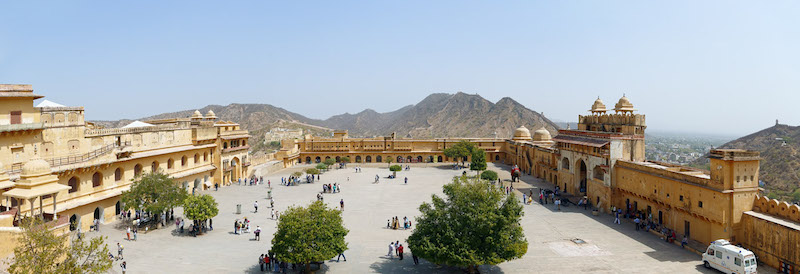
From Jalebi Chowk, a grand staircase leads to the main palace grounds. On the right side of the stairs is the Sila Devi temple, where Rajput Maharajas worshiped from the 16th century until the 1980s when the ritualistic buffalo sacrifices ended.
The Sila Devi Temple features a silver-covered double door with a raised relief. Inside, the main deity, an incarnation of Kali or Durga is accompanied by two silver lions. According to legend, Maharaja Man Singh sought blessings from Kali before battling the Raja of Jessore in Bengal. In a dream, the goddess instructed him to retrieve her image from the sea bed, leading to the installation and worship of Sila Devi. At the temple entrance, there is a single-piece coral carving of Lord Ganesha.
The Ganesh Pol, or Ganesh Gate, serves as the entrance to the private palaces of the Maharajas. Named after the Hindu deity Lord Ganesh, this three-level structure adorned with frescoes was commissioned by Mirza Raja Jai Singh (1621-1627). Above the gate is the Suhag Mandir, offering a view of the Diwan-i-Aam functions through latticed marble windows called “jâlîs.”
2. Second courtyard:
The second courtyard, reached by ascending the main stairway from the first courtyard, contains the Diwan-i-Aam, also known as the Public Audience Hall. This elevated platform features a double row of columns adorned with 27 elephant-shaped sculptures, and accompanied by galleries above. As its name implies, this was the place where the King held an audience to listen to and address public petitions.
3. Third courtyard:
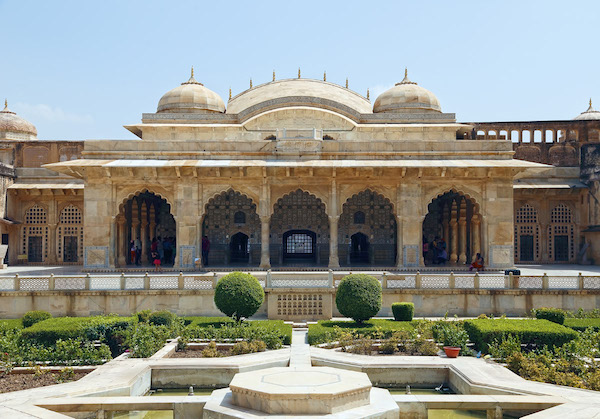
The third courtyard housed the private quarters of the Maharaja, his family, and attendants. Inside the courtyard, two buildings stood facing each other, separated by a Mughal-style garden. On the left side of the entrance gate was the Jai Mandir, a stunning structure adorned with glass inlaid panels and multi-mirrored ceilings. These convex mirrors, embellished with colored foil and paint, sparkled brilliantly in candlelight. Also known as Sheesh Mahal or the mirror palace, this architectural gem was built by King Man Singh in the 16th century and completed in 1727, marking the foundation year of Jaipur state.
Facing the Jai Mandir in the courtyard was the Sukh Niwas or Hall of Pleasure. This hall could be entered through a sandalwood door and boasted walls adorned with marble inlay work. The hall was kept cool by a piped water supply flowing through an open channel, creating an environment akin to an air-conditioned space. The water from this channel eventually flowed into the garden.
One captivating feature of the courtyard was the “magic flower,” a carved marble panel located at the base of one of the pillars near the mirror palace. The panel depicted two butterflies hovering above the flower and displayed seven unique designs, including a fishtail, lotus, hooded cobra, elephant trunk, lion’s tail, cob of corn, and scorpion. Each design could be seen by partially hiding the panel with one’s hands.
Situated between the Jai Mandir and the Sukh Niwas on elevated platforms, the garden was designed by Mirza Raja Jai Singh (1623–68). It followed the layout of the Chahar Bagh or Mughal Garden, with a sunken bed shaped in a hexagonal pattern. Narrow marble-lined channels surrounded a star-shaped pool with a central fountain. Water cascaded through channels from the Sukh Niwas and the “chini khana niches” on the Jai Mandir’s terrace, adding to the garden’s beauty.
The Tripolia Gate, meaning “three gates,” served as the entrance to the palace from the west. It opened in three directions, leading to the Jaleb Chowk, the Man Singh Palace, and the Zenana Deorhi in the south.
4. Fourth courtyard
The fourth courtyard served as the residence for the Zenana, comprising the royal family’s women, including concubines and mistresses. Within this courtyard, numerous living rooms provided accommodation for the queens. The design allowed the king to visit any queen of his choice without revealing which one he was visiting, as all the rooms opened into a shared corridor.
Located south of this courtyard is the Palace of Man Singh I, the oldest section of the palace fort. Construction of this palace spanned 25 years and was completed in 1599 during the reign of Raja Man Singh I (1589–1614). It served as the primary residence within the complex. This pavilion, formerly veiled for privacy, served as a meeting place for the maharanis, the queens of the royal family. Open balconies connected the pavilion to several small rooms on all sides.
Activities and Points Of Interest at Amer Fort:
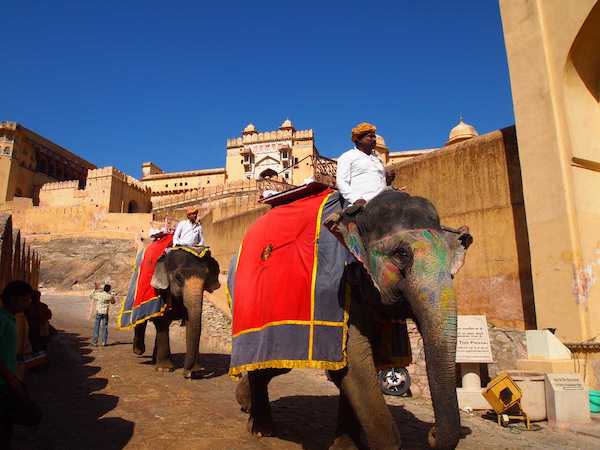
While visiting the Amer Fort in Jaipur, there are various activities that you can indulge in and enjoy. A few of our favorites are:
1. Amer Fort Light and Sound Show:
The show brings the glorious history of the Rajput kings, who constructed this magnificent fort, back to life. When night falls, the entire fort is adorned with enchanting lights. The show begins by narrating the tale of the fort’s creation and continues to depict the regal lives and reigns of the kings.
The story is filled with inspiring accounts of the Rajput kings’ bravery and splendor, made even more iconic by the distinctive voice of Amitabh Bachhan as the narrator. The words are beautifully crafted by the renowned Gulzar.
One remarkable aspect of the show is the high-quality HD surround sound that provides an unforgettable experience. As you sit on the open-air terrace, you’ll be captivated and transported. The music, composed by esteemed singers like Sultan Khan and Shubha Mangal, adds to the magic.
The show has a runtime of approximately one hour and concludes with the fort’s opening to the public. The story is available in both English and Hindi. The English show takes place at 6:30 pm (October – February) / 7 pm (March – April) / 7:30 pm (May – September) every night at 6:30 pm at Kesar Kyari on Maota Lake at the foot of Amer Fort. It cost INR 295 for foreigners.
2. Elephant Rides:
Elephant rides are available at the fort for INR 1,100. However, as mentioned, riding elephants can be extremely damaging to the animals as they are not made to carry loads on their backs. Moreover, the wooden platforms used for seats can be heavy and clunky causing a great deal of blisters and damage to the elephant’s skin.
Elephants endure tremendous mistreatment to be tamed for the purpose of carrying passengers. Because of this and other ethical reasons, we strongly suggest avoiding this activity. Take photos of the beautiful creatures instead, and bask in their glory!
3. Museum and Garden Visit:
Immerse yourself in the rich history of the palace and the Rajputs by exploring the one of the best museums in Jaipur. Inside the museum, you’ll discover a stunning collection that showcases the legacy of the Rajputs. Additionally, the Char garden within the fort is a sight to behold, offering awe-inspiring vistas of the charming town below.
4. Dance Programs:
In the evening, Sukh Mahal hosts captivating dance programs for your entertainment. Simply head to the ticket counter, secure your tickets, and delight in the mesmerizing performances of classical Rajasthani dance.
5. Puppet Shows:
You will also be able to see puppet shows which Rajasthan is famous for. These captivating performances create a lively and engaging atmosphere for the visitors. The traditionally dressed, small puppets showcase amusing tricks and dance moves are particularly enjoyed by tourists and children.
Things to see at Amer Fort Jaipur:

Exploring the grandeur of Amer Fort is an experience that will take you over 3 hours. Here are some must-see attractions within the fort:
1. Suraj Pol:
This is the fort’s entrance gate, known for its zig-zag path often featured in Bollywood movies. You can reach here while walking alongside elephants to the main entrance of the fort.
2. Jaleb Chowk:
As the fort’s first major courtyard, it served as a gathering place for soldiers. Jaleb Chowk is home to the renowned Shila Devi Temple, known for its animal sacrifice ritual. You can take in the beautiful courtyard which is beautiful for pictures. A short flight of steps leads to the fort’s second courtyard.
3. Ganesh Pol:
This gate, with its artistic excellence, is the most famous gate of Amer Fort on Instagram. It is the main gate of the palace and features small windows designed for the royal women to observe their surroundings.
4. Diwane-E-Aam:
Situated opposite Ganesh Pol, this is the hall of common audience. It is where the king would address the public and listen to their grievances.
5. Jai Mahal (Diwane-E-Khas and Jai Mandir):
Diwane-E-Khas, the hall of private audience, is beautifully decorated and was used for exclusive meetings with the king. The pillars of Diawane-E-Khas showcase the famous magic flower of the Mahal. Jai Mandir, another part of Jai Mahal, provided a space for relaxation and featured bathing chambers with khus curtains.
6. Sheesh Mahal:
The Sheesh Mahal is the most renowned and visited section of the palace. A single candle can illuminate the entire palace through its numerous mirrors. While the ceiling resembles a night sky filled with sparkling stars.
7. Sukh Niwas:
This area served as the king’s resting quarters and is located directly across from the working chamber. Along the Sukh Niwas, you will find rooms belonging to the king’s various queens.
8. Zeena Mahal:
This section was the residence of the queens and women of the royal family. The outer courtyard provided a relaxing space for the queens and kings. Each room in Zeena Mahal had its own kitchen and sitting area, resembling royal row houses.
Best Time To Visit Amer Fort:
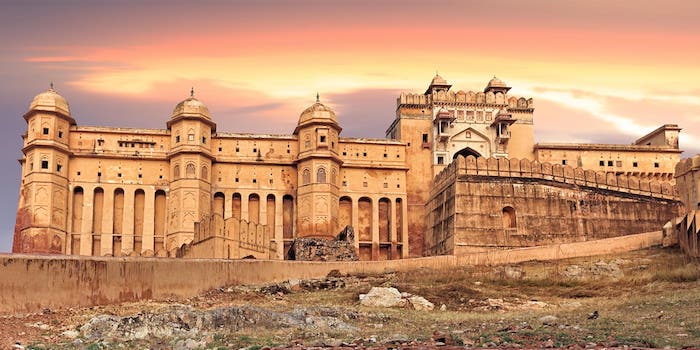
It is best to visit Amer Fort from September to March, when the weather is pleasant and cool, providing a comfortable experience. For visiting hours, the best time to explore the fort is from 7 pm to 9 pm. During this time, you can indulge in the captivating sound and light show while enjoying a delightful dinner at the restaurant, adding an extra touch of magic to your visit.
Additionally, it is advisable to avoid visiting in May when the heat becomes extremely hot, as it was over 42 degrees everyday when we were in Jaipur. To make the most of your visit, it is recommended to arrive at Amer Fort early in the morning. This allows you to avoid both the intense heat and the large crowds that tend to arrive from 10 am onwards. Taking advantage of the early morning hours ensures a more peaceful experience with fewer visitors.
How Long Will It Take To See Amer Fort in Jaipur?
One can see Amer Fort in 2-3 hours. However, if you are like me and want to take photographs, and see absolutely everything the fort has to offer, it will be better to plan to spend at least 4-5 hours in and around the palace.
Where is Amer Fort, and How To Get To There?
Amber Fort is situated approximately 11 km northeast of the central area of Jaipur (Hawa Mahal and City Palace area), nestled amidst the expansive and rocky Aravalli mountains that encircle the northern part of the city.
Below are a few ways you can reach the Amer Fort.
1. Public Bus
To reach Amer town, you can take public bus routes #1, #5, or #3B from Ajmeri Gate or Hawa Mahal. Buses operate every 20 minutes, and the journey takes around 40 minutes. The fare is approximately INR 15 for non-AC buses and INR 30 for AC buses. Listen for the conductor calling out “Amer” to ensure you board the correct bus!
2. Auto Rickshaw / Taxi
Taking an auto-rickshaw or taxi is another option. The journey typically takes 15 minutes, and the cost for a round trip is roughly INR 500. This can be a reasonable price if shared among a group, but remember to negotiate a bit for a better deal.
If you want to skip negotiating all together, I recommend using Uber or Indrive to make things easier!
Do You Need a Guided Tour at Amer Fort?
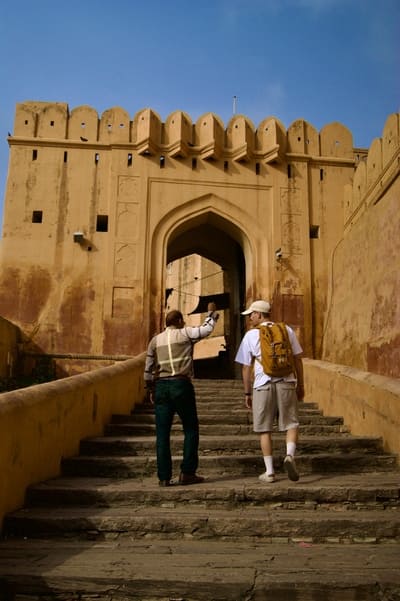
The decision to hire a guide or explore on your own is entirely up to you! However, if you value hearing the detailed history of Amer Fort, understanding its significance, and learning fascinating facts about each section of the palace without getting lost in its labyrinthine hallways, we highly recommend hiring a guide.
You can book a guide in advance (take a look at this highly-rated guide), or you can find one on-site. Head towards the main ticket counter in the Jaleb Chowk courtyard, where you’ll find numerous authorized tourist guides vying for the opportunity to show you around the fort.
Ensure that your guide has a valid ID before beginning the tour to avoid any unpleasant surprises. On average, a one-hour guided tour should cost you approximately INR 300.
Alternatively, exploring the Amer Fort complex without a guide is also a viable option! Without a guide, you can take your time and explore every corner at your own pace. If you’re willing to do some research beforehand and download a map on your phone, you’ll have the freedom to navigate the fort independently.
Amer Fort in Jaipur: The Complete Guide To The Beautiful Palace in Rajasthan
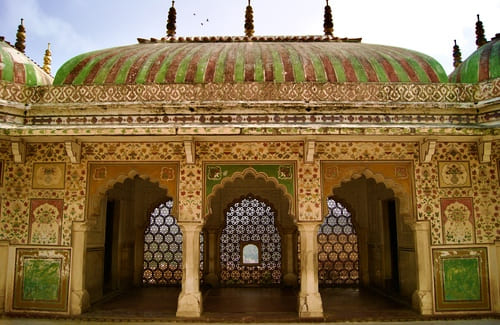
Amer Fort stands as a mesmerizing symbol to the rich history and architectural brilliance of Rajasthan. Situated amidst the Aravalli mountains, this magnificent fort offers a captivating journey through the opulent lives of the Rajput kings.
From its grand entrance gate, Suraj Pol, to the enchanting Sheesh Mahal, each corner of Amer Fort exudes an aura of grandeur and splendor. Visitors can explore the fort’s various attractions, including Jaleb Chowk, Ganesh Pol, Diwane-E-Aam, Jai Mahal, Sukh Niwas, and Zeena Mahal, each revealing unique stories and architectural marvels – perfect for photos.
Whether strolling through the fort’s intricate passages or admiring the panoramic views of Jaipur from its ramparts, Amer Fort leaves an indelible impression on every traveler. With its historical significance, stunning beauty, and cultural significance, Amer Fort unquestionably holds a place among the must-visit attractions in Jaipur.
FAQs: Amer Fort Jaipur
Below are some of the most frequently asked questions about the Amber Fort in Jaipur Rajasthan.
The entry price for the Amer Fort is INR 25 for Indian nationals, while Indian students are charged INR 10 per person. Foreign nationals have an entrance fee of INR 500 per person, and foreign student nationals pay INR 100 per person to enter the Amber Fort.
Break down of Amber Fort entry fees:
– 25 per person for Indians
– 10 per person for Indian Students
– 550 per person for Foreign Tourists
– 100 per person for Foreign Students
– 200 per person for Light Show in English
– 100 per person for Light Show in English
– 1100 per couple for Elephant Ride
Situated approximately 11 km from the main city, the Amer Palace Fort stands as one of the most famous tourist destinations in Jaipur. Perched atop a small hill, this expansive palace complex showcases its magnificent architecture crafted from pale yellow and pink sandstone, along with touches of white marble.
To make the most of your visit to Amber Fort, it is recommended to plan your trip during the early morning hours to avoid crowded tourist periods. Another ideal time is late afternoon, allowing you to marvel at the fort’s golden glow amidst the enchanting twilight colors. If you’re interested in an elephant ride at Amber Fort, please note that the timings for such rides are available from 9 am to 5 pm.
Yes you can go inside Amber Fort. Almost all of the complex is accessible to the public. You will need to buy an entry ticket to visit the fort.
